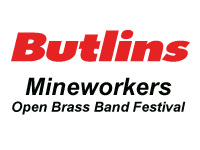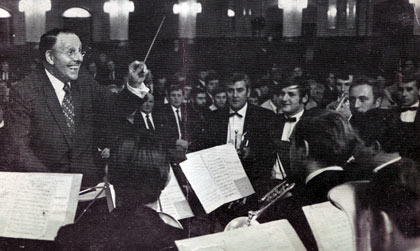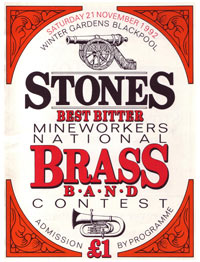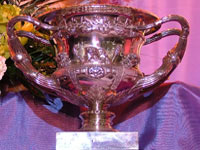2007 Butlins Mineworkers Championships - Introduction
16-Jan-2007Both Butlins and the Mineworkers have come a long way over the years to reinvent themselves here in Skegness.
 Oh we do like to be beside the seaside….
Oh we do like to be beside the seaside….
All right – it is the middle of a cold and windy January, we've had more downpours than the Amazonian rainforest and most players lips and constitutions are in a pretty awful state after weeks of carol playing and Christmas parties, but… the new brass band contesting season starts here at the Butlins Skyline Resort in Skegness.
Now secure in time and place as the first big brass band festival of the year, the Butlins Mineworkers Championships offers a brilliant way for bands to kick start their new season with some family orientated entertainment linked to some serious music making – and all with the added bonus of a veritable bucket load of prize money thrown in for good measure.
Just five years ago, the Mineworkers Contest was dead in the water; a bygone relic of an age when whole communities had two weeks every year to set up camp amid the chip shops and tacky amusement arcades of Blackpool. The ‘Miners Fortnight' was as much a holiday break as it was a symbol of working class solidarity: come work or play, everyone associated with the local colliery did it together – from staying at cramped Bed & Breakfast's with their terrifying landladies to taking part in the Coal Industry Social and Welfare Organisation brass band contests.
Peak Years
At its peak in the early to mid 1960's, the population of Blackpool almost doubled in that fortnight as families from as far afield as Scotland, Wales, Yorkshire and Kent made their way to the entertainment mecca of the North. With the destruction however of the mining industry at the hands of Mrs Thatcher and her American hatchetman Ian McGregor that all changed, although it must be said that a major part of the decline also occurred when better paid mine workers became free to choose their holidays throughout the year – many deciding that the golden sands of Benidorm were better than the ‘Golden Mile' of the Blackpool promenade.
The real golden years of coal mining production however were pre Second World War as even in the 10 year period after Nationalisation in 1947 pit numbers fell from 950 to 822 and by 1963 to around 560. The number of miners fell from over 750,000 to 320,000 by 1963 and to around 200,000 by the 1984 strike. The ‘Great Strike' as the NUM called the 1984 industrial dispute resulted only in a complete annihilation of the industry.

George Thompson conducts Grimethorpe Colliery Band in 1969 including a young Peter Roberts on soprano cornet
In its finally few years ‘The Miners' was a sad and hollow reminder of a time that had passed – no longer a celebration of what was great about a vibrant body of men and women, but an extended wake for the dead. Even the brass band contests, the heartbeat of its musical body since 1962 had become irrelevant. The great days when the likes of Carlton Main and Jack Atherton, Markham Main and Walter Hargreaves, Grimethorpe and George Thompson, Cory and Arthur Kenney were but distant memories too. What used to be termed ‘The Third Major' had become a minor sideshow.
Aberfan disaster
In 1970, before the first of the two major miners strikes that finally brought down Edward Heath's Government, the Mineworkers Championships held at the Winter Gardens, Blackpool attracted 53 bands. The Cory Band under Arthur Kenney won the top prize of 200 guineas and the Lord Robens Challenge Trophy in the Championship Section. Robens incidentally was the reviled Chairman of the National Coal Board, who tried to whitewash the findings of responsibility of the Aberfan disaster in 1966.
 Here where bands such as Carlton Main, Cory, Grimethorpe and Markham Main up against the likes of lesser known lights such as Dawdon Lodge from Durham, Ashington from the North, Lochgelly from Scotland and Markham and District from Wales. In the Second Section there were bands such as Pegswood and Pelton Fell, Washington ‘F' and Netherton Colliery. The Third Section had Crooke and Kirkless, Kelty and Blairadam, Snowdown and Ynyshir and Tymawr. The Fourth Section contained the names of Ryhope, Ogmore Valley, Lynemouth and Handen Hold. Where are they all now?
Here where bands such as Carlton Main, Cory, Grimethorpe and Markham Main up against the likes of lesser known lights such as Dawdon Lodge from Durham, Ashington from the North, Lochgelly from Scotland and Markham and District from Wales. In the Second Section there were bands such as Pegswood and Pelton Fell, Washington ‘F' and Netherton Colliery. The Third Section had Crooke and Kirkless, Kelty and Blairadam, Snowdown and Ynyshir and Tymawr. The Fourth Section contained the names of Ryhope, Ogmore Valley, Lynemouth and Handen Hold. Where are they all now?
It was also a time when the mining industry also supported an ancillary industry all of its own too with companies such as Lindley Ltd of Queensbury, Caladonian of Newark, Mine Safety Appliances of Coatbridge, DOSCO, Schwarz-Holywell, Dowty and Goodhall Clayton all taking out adverts in the programme. Where are these now?
By 1976 it was £210 for the Champion Band (Grimethorpe under Ernest Woodhouse) with 58 bands taking part as the Miners enjoyed good relations with the then Labour Government. 17 bands took part in the Championship Section with the likes of Washington Welfare, Calverton Colliery and Shirland Miners Welfare rubbing shoulder with the big boys. In the lower sections there was Teversal Colliery, Benwhat Silver, Ystalyfera, Arley Welfare, Mainsforth, Blackhall, Bold Miners and Abertysswg – names now lost in time. The winners had their pictures taken for the industries own newspaper, ‘Coal News'.
Miners Strike
Four years after the end of the 1984 Miners Strike and sponsored by Stones Best Bitter, the 1988 contest still had the feel of importance and relevance with 59 bands taking part. The weekend also included the CISWO Solo Contests too (introduced in 1982) where some famous names appeared to put their reputations on the line: Mark Walters and Peter Roberts of Grimethorpe, Ian Robinson, Dave Barringer and Alan Fernie to name but a few.
Numbers remained pretty constant up until the early 1990's with around 60 bands making it to the stage, but there was a last hurrah in 1992 when as almost a last two fingered gesture to the impending Tory Government inspired pit closures 72 bands took part, with also a tremendous entry in the solo competitions: 34 players played in the Junior Contest and 27 top players battled it out in the Senior Section where Mark Walters took the first prize ahead of Peter Roberts.
The CISWO organisation was still keen to point out that its primary purpose was to support mining families with the miners themselves paying 6p per week to the Benevolent Fund to help those who had accidents, fallen on hard times, needed help with children with disabilities or even died in digging up the black gold from underground. Little did they know how much that benevolence was need in the next few years: In 1992 for instance, it paid out £1,753,566 to 4,362 beneficiaries.
Death knell
The early 1990's mine closures were the death knell for the contest and numbers, slowly at first, but with tragic regularity fell away over the intervening years. 60 bands took part in 1994, by 2000 it was 51 and falling, and that with the rules relaxed and a blind eye turned to the usually strict entry requirement that 50% of the playing members had to be persons employed in the coal mining industry or their dependent children or members of Miners Welfare Schemes. Many bands met the requirements by signing up as members of their local NCB Club.
It could not last and with the decision made to stop the contest it looked like one of the great brass band occasions was finally beaten and would die. Thanks though to some determined efforts by the likes of Stan Lippeatt and others, Butlins saw the potential in resurrecting the Mineworkers Championships.
In its way Butlins mirrored the fate of the mineworking industry. Once the holiday choice of hundreds of thousands of hard working families it too had found life hard in the competitive Thatcherite 1980's. Why choose Skegness when you could spend your money in the newly constructed hot spots of the Spanish Costa Blanca, and why brave the British weather when you could return home with a suntan every bit as brown and crispy as the posh people who spent thousands going to Barbados?
Traditional values
Thankfully, Butlins took the decision to invest in the contest in 2002, and invest heavily in attracting the families back, not perhaps for a full fortnight, but for extended breaks instead. Much of the traditional values remain – family orientated entertainment, wholesome grub, a safe place to let the kids run free and value for money, but they have also upped their game in respect to what was perceived as their weaknesses too. The accommodation is now very good indeed – warm and welcoming, clean and well maintained, and with those little extras that used to cost you a fortune in 10p pieces in the meter such as the television and extra heating now all as standard. It is a bit of an eye opener.
It may seem like a romantic story on the face of it, but scratch beneath the surface a little and you will see that there is some hard nosed number crunching going on too. Get over 70 bands to come to a holiday resort that offers you the chance to spend lots of money in one place only, and in return you can afford to be very generous with the prize money on offer.
And it is a very generous prize fund – the biggest in the brass band movement, with a headline top prize for the Championship winners of £6,000 with the chance to boost that by an additional grand and more. No wonder band treasurer's eyes light up when they get their entry form back.
In the other sections there is plenty of dosh on offer with top prizes of £1,200 in each of the lower sections as well as generous awards for the bands coming second, third and fourth.
Investment paying off
The investment seems to be paying off as this year 76 bands will take part in the contest. The requirement to be linked to the mining industry no longer applies, but with a nice sense of historical perspective, 28 of the competing bands this year have a direct link to the industry. Like long lost relatives researching their family tree, the links with the past are being found again.
The 2007 Bultins Mineworkers Festival is now a vibrant addition to the brass band movement. Not only is there a record turn out of bands, but those links with both their proud pasts is enhanced too.
 The winning band in the Championship Section will take away with it the £6,000 top prize, but will also be able to display the famous 200 year old Warwick Vase Trophy, which was presented to the contest by the late F.A Mitchell- Hedges, the famous explorer and author. In addition, the Entertainment winners will take home with them the equally impressive Butlins Trophy that used to be presented to the Butlins Youth Champions each year at the Royal Albert Hall in the early 1970's.
The winning band in the Championship Section will take away with it the £6,000 top prize, but will also be able to display the famous 200 year old Warwick Vase Trophy, which was presented to the contest by the late F.A Mitchell- Hedges, the famous explorer and author. In addition, the Entertainment winners will take home with them the equally impressive Butlins Trophy that used to be presented to the Butlins Youth Champions each year at the Royal Albert Hall in the early 1970's.
The mineworking industry may now be just a fraction of its former glory, but in its way that has not been a bad thing – even though the way in which it was destroyed most certainly was. The industrial landscape from which the 76 competing bands come is no longer scarred with tips and spoil, and their musical composition has changed forever too. Are there any players currently working in the mining industry performing here this weekend? Now they come from colleges, offices and teaching, and not from a dirty pit face.
Butlins too is catering for a new generation – those who know they have choice and want value for money, those who demand good entertainment, good food and accommodation that feels like a home and not an army camp. They have succeeded, and with their help so too will the Mineworkers Brass Band Championships.
Iwan Fox















